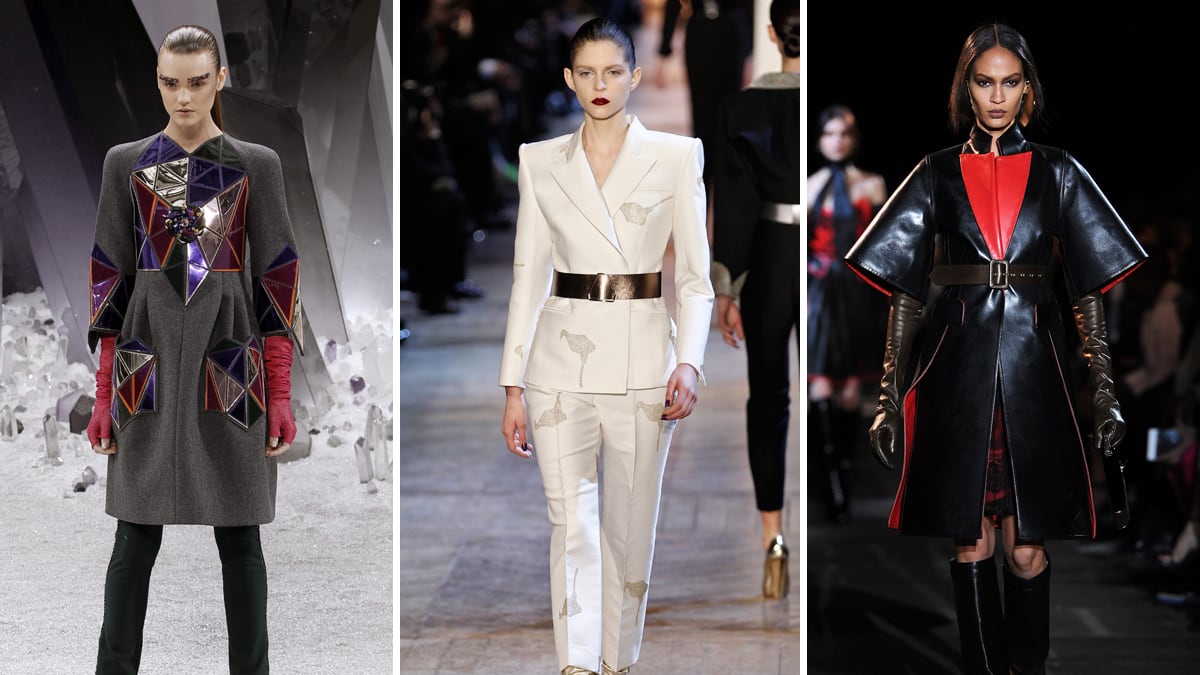
Among the prestigious design houses that give French fashion its mystique in the broader culture, Yves Saint Laurent ended a chapter with proud confidence at its Fall 2012 show, while Givenchy pointed toward an exciting future, and Chanel, it seems, is in stasis.
The clothes that designer Stefano Pilati created for his final collection at YSL smoldered with audacity and dark sexuality. The clothes stirred passion and demanded attention. Yet this last presentation was a calm affair, one that exuded professional rigor and respect rather than any emotion akin to sadness, regret, or acrimony.
Executives at YSL announced Pilati’s departure more than a week ago, as the shock waves of Raf Simons’s departure from Jil Sander were still roiling the fashion industry. Pilati had been dogged by rumors that he was on his way out of the storied house almost from the moment he arrived. Over the years, his collections were both praised and criticized, but he nonetheless made his mark on the brand with his ability to capture the perfume of French chic with his bubble skirts, Tribute bag, and double platform pump.
ADVERTISEMENT
Pilati presented his last collection as the Paris Fall 2012 season is in its final days. In a long sliver of a shadowy room, before an audience of editors and celebrities such as Katy Perry and Salma Hayek—wife of YSL corporate head Francois-Henri Pinault—models strode along a wooden floor made shiny from age. The dignified black YSL logo hung on a gilded backdrop. The models wore high block pumps with mirrored heels that had some of the young women teetering at a dangerous pitch and had others moving with impressive grace.
It was a predominantly black collection—with jolts of white and purple—filled with slim, high-waist trousers, belted jackets, and lush leather tops with roomy elbow-length sleeves. Pilati crafted slim skirts and open-back dresses out of seductive silver chain mail; jacket lapels were richly lined in silver mesh; and a glamorous white tuxedo was embroidered with silver calla lilies.
Calla lilies, with their trumpetlike shape, are considered a symbol of purity and rebirth. They are favored at both weddings and funerals—beginnings and endings. And to see them as such a central theme in the collection—through embroidery, appliqué, and prints—gave this finale a kind of sweet inevitability.
When the last model made her pass down the corridor lined with guests, the thunderous music paused briefly. The audience continued its applause. And when the designer emerged, folks rose to their feet in a gesture of respect. Pilati wore a dove gray suit and merlot-colored scarf. He took a brief walk down the runway to absorb the moment.
He was leaving YSL with a collection that spoke of the brand’s history while also exuding modern sex appeal and daring. He had added to the house’s aesthetic vocabulary and helped it to churn toward profitability. He had accomplished a great deal.
The designer smiled and then made his way backstage. It was a quiet and simple end to a tumultuous tenure. A new designer is expected to be announced shortly.
At Givenchy, designer Riccardo Tisci has settled into a house once defined by the gamine aesthetic of Audrey Hepburn. He has transformed it into a label with a dark, wry, and powerful stance: more Girl With the Dragon Tattoo than Breakfast at Tiffany’s.
The collection he showed for fall captured all those provocative elements with skill and elegance. His tailored jackets with their collage of textures and mix of charcoal gray and black had strong shoulders, nipped waists and a back view that hinted at formal tails and peplums. His trousers were lean but softened by pleats. He layered a scrim of black chiffon over lingerie-style dresses in red, and he adorned a bare, purple slip dress with gems.
Tisci often walked a fine line with some of his dresses teetering towards a brand of sexuality so overt as to be nearly vulgar. If he crossed that line with a frock or two that were perfect for a naughty night out, he offered reassurance that it was just a tease—a provocative aside. It was not the essence of his aesthetic argument.

While Givenchy is engrained in cinematic mythology, no fashion house competes with Chanel in its dominance of the cultural—and status-conscious—imagination. The Chanel handbag and the brand’s other accessories are such moneymakers that they alone often generate enough income to virtually keep a specialty store afloat.
Designer Karl Lagerfeld has been instrumental in keeping the Chanel brand alive and relevant by tapping into shifts in music, social media, and the like. But the Chanel collection he presented for fall was weighed down by his own inspiration, which appeared to be crystals, stalagmites, and minerals.
The runway at the Grand Palais was covered in white crystals with large reflective spears jutting from the ground. Sparkling rocks were clustered in piles. The setting promised a collection that was light and ethereal. Instead, Lagerfeld explored the darkness of malachite, iron ore, and marcasite. The clothes were dominated by gray, murky green, midnight blue, all with hints of iridescence. At its best, gold-splashed feathers adorned wide collars and clear gemstones decorated the cuffs and neckline of an easy gray dress with an Empire waistline.
But when the sleeves of a coat were pieced together to resemble the facets of a crystal or when the bodice of a dress was transformed into a reflective bib, the inspiration became a distraction and a burden. It was a disappointing collection that did little to make the Chanel brand shine brighter. But it will surely keep its bag business going strong.





